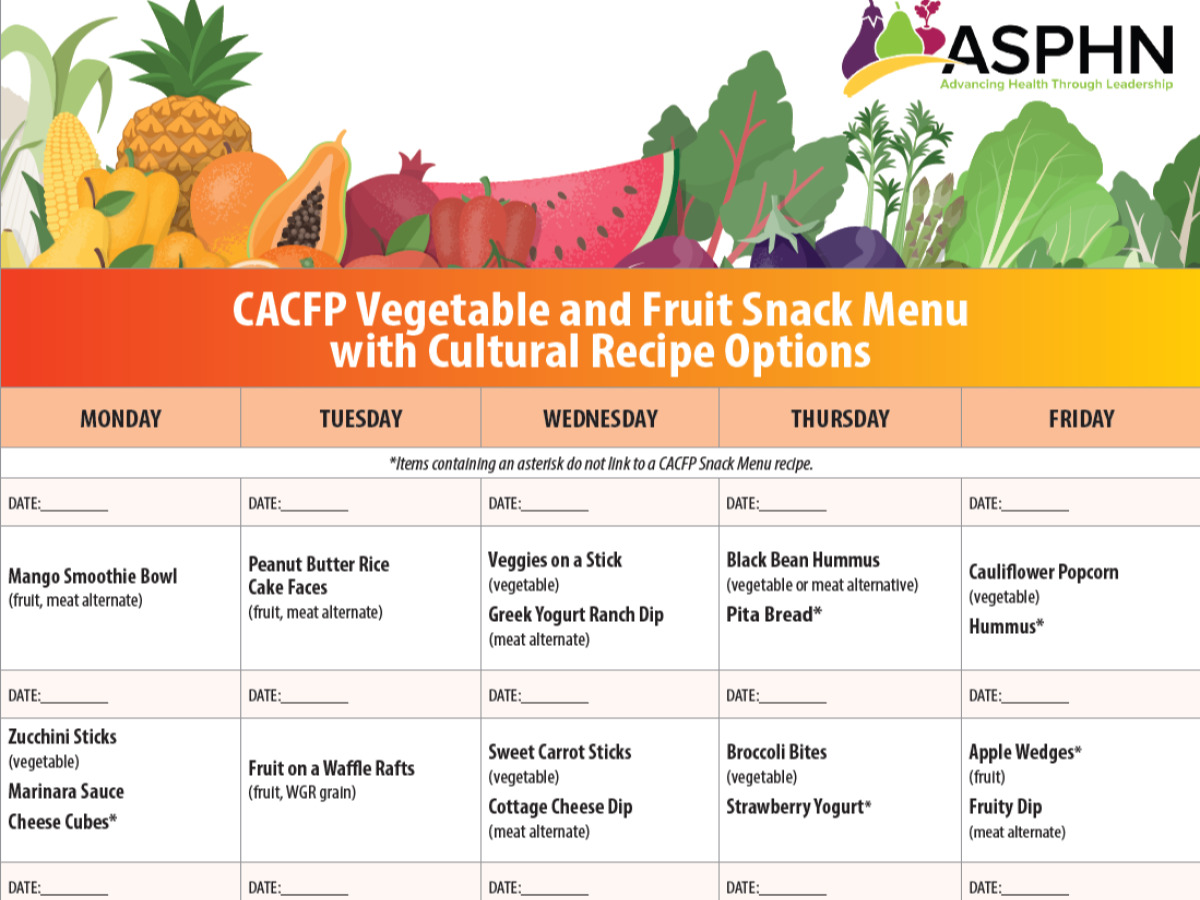Making Recipes More Culturally Aligned with Communities
Association of State Public Health Nutritionists (ASPHN)
July 30, 2024

Check out ASPHN's new cultural recipes and resources available on their CACFP Vegetable and Fruit Snack Menu. It features different ethnic foods of different regions. Some cultural options include Hispanic, Afro-Caribbean, Middle Eastern, and Polynesian. Recipes are provided to make preparation easier! There are also tips for how to incorporate cultural diversity into recipes.
A Recipe Tool for Providers
The CACFP Vegetable and Fruit Snack Menu was developed by ASPHN’s Fruit & Vegetable Nutrition Council to help providers more easily plan, prepare and provide healthier snack options for children.
Snack time is the perfect time to offer vegetables and fruits to the children in your care! Fresh, frozen, canned, or dried — vegetables and fruits add color, texture, fiber, vitamins, and minerals to the menu. Including these nutritious gems at snack will help children develop healthy eating habits that can last a lifetime.
It’s a fact that most children in the United States do not eat enough vegetables and fruits. We all want our children to be healthy, and providers play an important role in helping children choose healthy foods. This menu provides a month’s worth of snack ideas featuring a variety of vegetables and fruits to make it easier for providers to serve more every day.
Tips for Using the Snack Menu
Below you’ll find the CACFP Vegetable and Fruit Snack Menu with Cultural Recipe Options. There are a lot of different ideas on the menu, but you don’t need to do a complete overhaul of your menus all at once. It’s okay to start slowly and gradually work towards adding more vegetables and fruits at snack time. You can always make substitutions if you think a different vegetable or fruit would be a hit, or if you find a good deal on a different item. Use the menu as a springboard to make your snack menu colorful, creative, and healthy!
Cultural Recipe Options
Culturally-diverse recipes are an enticing way for young children to experience a variety of vegetables and fruits. Children and families also learn and connect with world cultures through diverse recipes.
Why Serve Cultural Foods in CACFP
- Broadens participant viewpoints through new foods and menu variety
- Offers participant learning opportunities on world cultures
- Makes families and participants feel welcome
- Creates a fun way to discover new foods and explore recipes
- Spices up side dishes and snacks, making them more enticing
- Adds budget-friendly options to the menu
- Offers connections to cultural heritage, immigrant identity, religious adherence, and social groups
- Provides mealtime opportunities for socialization and enrichment – Serving cultural foods can maximize growth in both these areas as participants learn and experience a new culture through food.
Ideas for Making a Recipe More Culturally Diverse
- Select CACFP-standardized multicultural recipes
- Communicate with families about specific ingredients or dishes they make at home that can be added into menu rotation
- Offer recipe sampling and food activities with participants as a fun way to improve acceptance of new food items
- When introducing a new food, make sure it is creditable in the CACFP prior to purchase. Remember that dessert-like items may not credit.
- When introducing a new ingredient, ensure allergen information is considered, such as the use of fish sauce or pre-mixed spice blends that may contain sesame, wheat or soy.
- Modify spices in a recipe as needed. With a new spice, you can start with a small amount and add more later to taste.
- Provide substitutions to the recipe if necessary. For instance, if a certain food item is not available in your area or out of season, substitutions of a similar item would be helpful to make the recipe as culturally appropriate as possible.
Download the Vegetable and Fruit Snack Menu with Cultural Recipe Options, search for cultural recipes, or search ASPHN’s full recipe collection.
